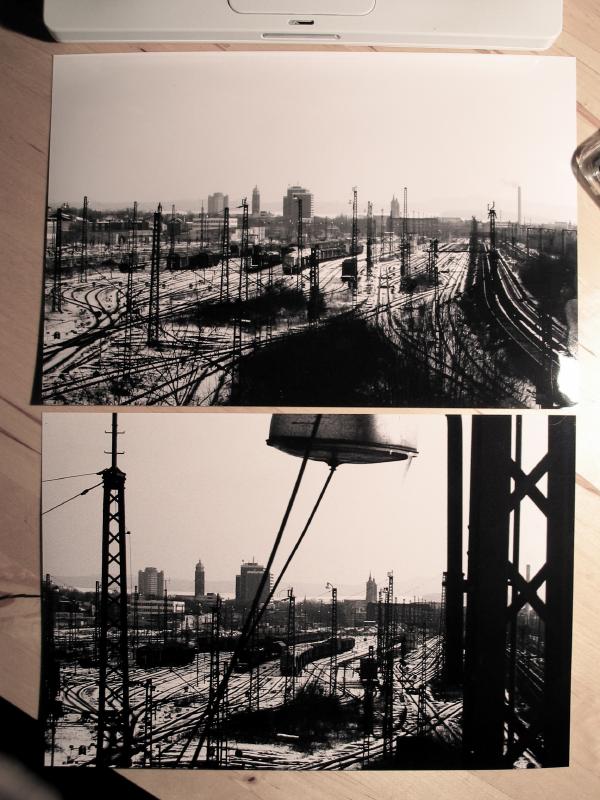Digital analogy¶
856 words on Photos
More about photos and me doing loads of ridiculous things.
I may have mentioned our little photo excursion and the rough plan to do a little shoot out between old-school analogue and new school digital photography by taking similar photos with a 2005 Nikon D-70 and an early 1980s Canon T-70 camera. The whole ‘shoot-out’ thing is probably quite absurd as I’m pretty sure that you can take good photos with both cameras. I’ll have an advantage with my T-70 because I have got better lenses and Jan-Philipp will have an advantage with his D-70 as he can take take more risks and take more experimental shots without having to wait or pay a lot to see them. So in total, we’re even…
We had the vague idea to do a little ‘exhibition’ with photos taken of similar views with both cameras. There seem to be two ways of doing that. The first is to try and make it hard to tell which camera the photo is taken with. The charme of that would be that we could work the ‘shoot-out’ idea by hanging the similar shots next to each other and then letting people decide which one they like better. In a way that could give a hint about which camera gives the better photos independent of the viewer’s preference in the digital/analogue question.
However, many open questions would remain in that approach. The increased liking/disliking could still be a matter of who took the photos. And, more problematically, I like to take black and white photos so I can develop them myself. So to make photos hard to distinguish, we’d have to turn the digital photos into black and white ones as well. And doing that is not only a very non-trivial thing to do which involves plenty of choices, it could also mean that the digital camera can’t live its potential to the fullest, which might be unfair. Just look at the two photos below to see how a rather cool photo can look pretty lame when taken in straight blakc and white.
A yet bigger problem would be that I can go and make the black and white prints myself – which I consider to be the most reasonable thing in the analogue spirit. On the other hand we’d have to give the digital photos to a digital lab. And I very much doubt that we’d be able to find a digital lab with photo paper that doesn’t just look differently than the paper I’m using. All the photo papers just seem to differ a little in shinyness, thickness or other small details.
So the only way to get the prints on exactly the same paper would be to have them done in the same lab. And for that I’d have to leave the analogue path and turn my analogue photos into digital ones. Which, incidentally, I recently did. And, for curiosity’s sake I had some digital prints made of those scanned analogue photos.
That, in turn, is a rather black box and unpredictable process. After mastering the initial hurdles of submitting the photos via the internet (imagine the upload starting just fine but deciding to cancel itself half an hour later because there were umlauts in some file names), it was no problem to order the prints. But even the choice of file format is a problem at that step. My scanned negatives ended up being 20 megapixel TIFF files. Not only is uploading those via DSL rather slow but with the sites I looked at you’ll just not find any accepting such files.
Actually, most of them seem to require JPEG compression anyway. Which in turn is pretty much the worst you can do to images a chief characteristic of which is to consist of rather finely grained dark dots. Add to that the somewhat hidden default setting of the site I used to ‘improve’ the photos (which gave some of the black and white ones a blueish colour that some people considered fashionable) and things are even less perfect.
All this is not to say that the photos I sent there look horrible (just some of them do) as those differences appear mostly in the details only. It just doesn’t seem particularly authentic. And neither do I have particulalrly much power to influence what exactly is done to the photos.
And thus, the second approach may be more useful: Not trying to turn this into a quiz but boldly using the differences of the digital and analogue worlds. Using the different papers that come with the different ways of processing them. Using colour prints for the digital photos if that looks better. And using post-processing – gradation for the analogue photos and the full power of RAW processin for their digital friends. That may do the better job of highlighting each technology’s strengths.
To finsh off, I present the height of absurdity: a low-resolution digital photo of digital prints I made of two similar photo. One of them came from the analogue world, the other one from the digital world. Which one is better? Which one is which?



